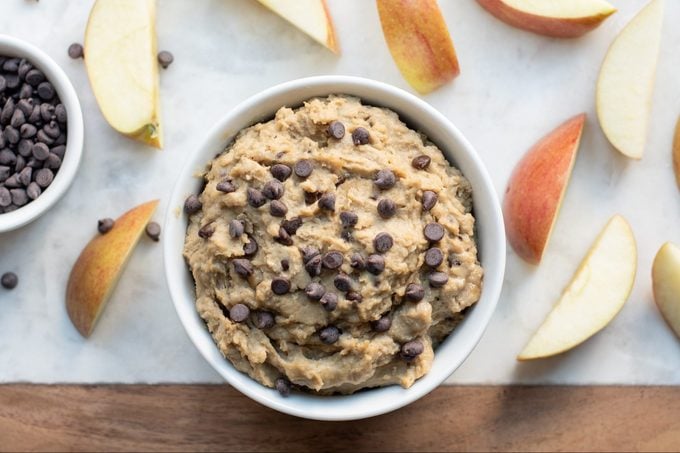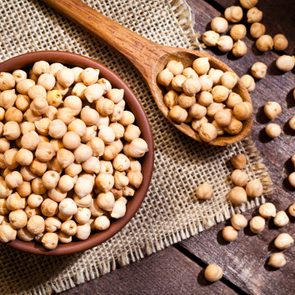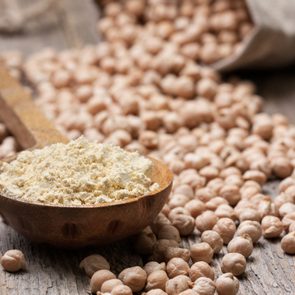A Chickpea Cookie Dough Recipe This Nutritionist Loves
Updated: Jul. 02, 2021
This chickpea cookie dough recipe may become your new favorite plant-based dessert. You can make it into cookies, a dip, energy bites, or even eat it raw (because it doesn't contain eggs).
Garbanzo bonanza
Search for chickpea cookie dough recipes on Pinterest, and no doubt you’ll find plenty of options. After all, chickpea cookie dough is tasty and versatile, and if it’s not already vegan, it can easily be altered to be completely plant-based.
That, and it’s a heck of a lot healthier than the tube of cookie dough you can get at the grocery store.
But with so many recipes out there, how do you know which chickpea cookie dough to make? That’s where we come in with this healthy, dietitian-approved chickpea cookie dough recipe.
Benefits of chickpeas
The chickpea, or garbanzo, plant (Cicer arietinum) is one of the earliest cultivated vegetables. It was among the eight “founder crops” domesticated in Mesopotamia more than 10,000 years ago, helping form the basis of human agriculture.
Chickpeas offer plenty of nutrition. One cup of cooked chickpeas provides 269 calories, 15 grams of protein, 4 grams of fat, 45 grams of carbohydrates, 13 grams of fiber, and lots of vitamins and minerals.
You’ll find both dried and canned chickpeas in the grocery store, but using canned chickpeas to make chickpea cookie dough is much faster and will make your life that much easier.

Why chickpea cookie dough is a delicious dessert
Unlike traditional cookie dough, this can either be eaten raw or made into cookies.
However you whip it up, this chickpea cookie dough from Kelsey Pezzuti, a registered dietitian in New Jersey, most definitely wins in the taste and texture department.
“This recipe is rich and creamy with a touch of sweet—just like the real stuff,” Pezzuti says. “It’s the perfect combination of chickpeas and sunflower seed butter. The ingredients’ neutral flavors balance each other out, while vanilla and honey bring a natural sweetness and cookie-dough-like aroma. The texture is identical to traditional cookie dough too.”
When it comes to eating the chickpea cookie dough, you have plenty of options.
“Eat it with a spoon, roll it into grab-and-go energy bites, use it as a dip, or freeze it for later,” Pezzuti suggests. If you decide to eat it as is, you can use sliced apples or pears for dipping.
Or bake the cookie dough into chickpea cookies. The heavenly scent coming from the oven will stop you in your tracks.
Chickpea cookie dough nutrition
You may be wondering how this cookie dough stacks up nutritionally. Here is the nutritional information and percentage of recommended daily values (DV) per serving:
- Calories: 270
- Fat: 16 grams (21 percent DV)
- Cholesterol: 0 grams (0 percent DV)
- Saturated Fat: 4 grams (20 percent DV)
- Sodium: 300 milligrams (13 percent DV)
- Carbohydrates: 28 grams (10 percent DV)
- Fiber: 6 grams (21 percent DV)
- Sugar: 11 grams
- Protein: 8 grams
- Calcium: 49 milligrams (4 percent DV)
- Iron: 2 milligrams (10 percent DV)
- Potassium: 310 milligrams (6 percent DV)
Why chickpea cookie dough is a healthier dessert
One of the major benefits of chickpeas is that they provide both protein and fiber, nutrients that will help you feel fuller for longer.
Plus, you get heart-healthy fats from the sunflower seed butter in this recipe, which also amps up satiety.
“The recipe uses whole food ingredients,” Pezzuti says. “These add fiber, healthy fats, and a bit of protein to a treat in which normally these nutrients are obsolete. Plus, this cookie dough is higher in protein and fiber and lower in sugar than regular cookie dough.”
The recipe requires no eggs or flour, which means you can eat it raw. “Since a stick of butter isn’t required, I’d say it’s still a healthier option,” Pezzuti adds.
If 270 calories for a portion of dessert sounds high, simply cut the portion in half.
Benefits of nutrients in this recipe
Vegans and vegetarians need to make sure they get enough iron. Just one portion of this chickpea cookie dough provides 2 milligrams of iron, or 10 percent of the recommended daily value.
Iron is necessary not only for carrying oxygen throughout the body but also for preventing anemia.
You also get vitamin E from this cookie dough recipe.
“Using sunflower seed butter over peanut butter gives you a boost of vitamin E,” Pezzuti says. “This is a powerful antioxidant essential for the immune system, blood vessel health, and protecting cells from damage.”
The recipe is heart healthy too. “Chickpeas are high in heart-healthy fiber, which can help lower your cholesterol,” she adds.
Why this is a crowd pleaser
Have gluten-free company coming over? You can whip up this chickpea cookie dough for them in less than five minutes. And if your guests are vegan, simply swap out the honey for maple syrup and use vegan chocolate chips.
And because this recipe turns a typically savory ingredient into a sweet one, it’s super palatable for even the pickiest of eaters.
“This is one of the best ways to get legumes into your routine,” Pezzuti says. “If you have someone at home who isn’t a fan of chickpeas, this cookie dough is a subtle and delicious way to add them to their diet. I call it a beginner chickpea recipe.”
Other substitutions to make
This recipe is already friendly to people with nut, dairy, and gluten allergies and sensitivities.
“Sunflower seed butter, honey, chickpeas, and vanilla are all naturally gluten free, dairy free, nut free, soy free, and egg free,” Pezzuti says.
And to make the recipe even heart healthier, use canned chickpeas with no salt added.

How to make this chickpea cookie dough
Without further ado, here is Pezzuti’s recipe for chickpea cookie dough. This recipe makes 10 servings.
Ingredients
- 2 (15-ounce) cans of chickpeas, rinsed and drained
- ¾ cup sunflower butter
- 2 teaspoons vanilla extract
- 3 tablespoons honey
- ½ cup semisweet chocolate chips
Directions
- Add all of the ingredients, except for the chocolate chips, into a food processor. Process until smooth.
- Mix in chocolate chips and enjoy.
How to turn this dough into cookies
To use this cookie dough in cookies, add in a half cup of gluten-free rolled oats, a half teaspoon baking powder, and a quarter cup unsweetened plant-based milk into the mix.
Preheat the oven to 350° F and coat a nonstick baking tray with spray oil. Portion the dough into tablespoon-sized balls and bake for 10 to 12 minutes.
If you decide to enjoy the dough raw, it will last refrigerated in an airtight container for up to a week.























